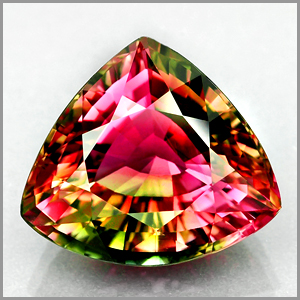October has two birth stone options… Pink Tourmaline and Opal
Tourmaline-
Tourmaline’s name means multi-colored, and rightfully so. These October birthstones come in every color of the rainbow, and even bi and tri-colored, where two or more colors appear together in the same gemstone. No two tourmalines are exactly alike. Tourmalines are believed to be a compassion fostering stone, also bringing composure and enlightenment, to those who wear it.
A deposit of tourmaline was found on Mt. Mica in Maine by two men who just happened to see a green crystal at the base of an uprooted tree, who didn’t know what it was. None of the locals could identify it, so it was sent to Yale University, where it was identified as tourmaline. Tourmaline was the first gem to be mined in such abundance in post-native North America. Mt. Mica tourmalines are particularly noted for their distinct green color resembling Granny Smith Apples.
Tourmaline’s many Varieties:
- Maine Tourmaline- Granny Smith green
- Watermelon Tourmaline- a bi-color stone containing green and pink tourmaline side by side.
- Rubelite- intense red color that stays the same color in both artificial and natural light.
- Paraíba Tourmaline- wasn’t discovered until 1987, commonly a bright blue to blue-green tourmaline
Tourmaline offers an enticing rainbow of options for your jewelry wardrobe. Cranberry red, hot magenta, bubblegum pink, peach and orange, canary yellow, mint, grass and forest green, ocean blue, violet, and even bicolor pink and green stones: tourmaline is all these and more.
Folklore/Myths & Facts:
According to ancient Egyptians, tourmaline, on its way up from the center of the earth passed over a rainbow. In doing so, it acquired all the colors.
The Empress Dowager Tz’u Hsi, the last empress of China, loved pink tourmaline above all other gemstones. She imported tons of tourmaline from Southern California in the early twentieth century, creating a gem rush in San Diego during the period.
It is believed that tourmaline protects its wearer from many dangers, such as falling.
Scientists are as interested in tourmalines as designers are. It’s peculiar that tourmaline can become electrically charged when rapidly heated and cooled. Even more peculiar is that when electrically charged, they will demonstrate pyro-electricity (i.e. having opposite charges at either end of the stone). This property has also made tourmaline the latest miracle ingredient in moisturizers: manufacturers claim the gem helps pull pollutants from your skin.
The Dutch were the first to bring tourmaline to Europe. Well aware of its heat conductivity, they would use a heated piece of tourmaline to heat their meerschaum pipes.
How to Care for Tourmaline:
Tourmaline is durable and suitable for everyday wear. Clean with mild dish soap: use a toothbrush to scrub behind the stone where dust can collect.


